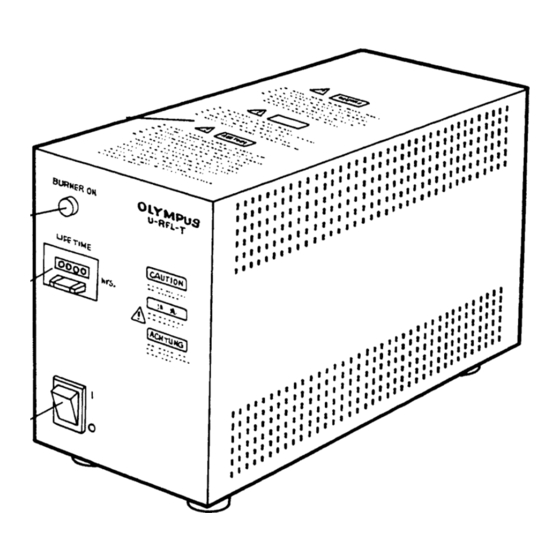Olympus U-RFL-T 사용 설명서 - 페이지 12
{카테고리_이름} Olympus U-RFL-T에 대한 사용 설명서을 온라인으로 검색하거나 PDF를 다운로드하세요. Olympus U-RFL-T 36 페이지.
Olympus U-RFL-T에 대해서도 마찬가지입니다: 사용 설명서 (16 페이지), 사용 설명서 (16 페이지)

3
USING THE CONTROLS
1
General Precautions for Observation
1. Make sure that the power cord and connecting cables are plugged in securely.
2. If you perform only transmitted light phase contrast or transmitted light DIC observations, leave one cube position on the
turret empty. This allows for transmission of white light.
The turret must always be set to one of the click position. If it is deviated from a click position, the cover may be deformed
by heat.
3. Always use Olympus immersion oil for oil immersion objectives.
4. If you use an objective with correction collar, you can correct contrast degradation due to variation in cover glass thickness
by adjusting the correction collar.
Correction procedure
If the cover glass thickness is known, match the correction collar to the cover glass thickness using the collar scale
provided. If the thickness is not known, turn the collection collar and adjust the fine adjustment knob to where the
image contrast is best.
5. Engage the shutter if you interrupt observation for a short time.
(Turning the mercury burner ON and OFF repeatedly will significantly shorten the life span of the burner.)
6. Color fading of specimens
This system features high excitation light intensity to ensure bright observation of dark fluorescence specimens.
In consequence, after long period of observations using high-power objectives, the colors of specimens will fade quicker
than usual, causing the view (contrast) of fluorescent images to deteriorate.
In such a case, slightly reduce the excitation light intensity to slow color fading down and improve the fluorescence
images.
To reduce the excitation light intensity, use ND filters or aperture iris diaphragm as far as the observation is not affected
or use the shutter to limit the exposure of specimen to more than necessary light.
Commercially-marketed color fading protection agent (DABCO, etc.) can also delay fading of specimen colors. The use
of fading protection agent is recommended especially when you perform high-magnification observations frequently.
Remember that the fading protection agents cannot be used with certain kinds of specimens.
CAUTION
2
Selecting the Fluorescence Mirror Unit
Select the fluorescence mirror unit which matches the fluorochrome in use.
} Usage according to the excitation light bandwidth:
A set combining excitation filters for different bandwidth can be used according to the type of excitation light.
The wide-band (W) set is normally used. However, when the fluorescence emitted from substances other than the
fluorescent stain is strong, the Narrow-band (N) set is recommendable.
9
